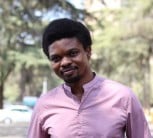The mining companies responsible for the pollution are often nowhere to be seen, but many Acid Mine Drainage clean-up technologies do exist. Clean-ups should take place in order to protect the right of citizens to a healthy environment and clean water.

Dr Alseno Mosai completed his undergraduate studies at the University of the Witwatersrand and joined the University of Pretoria (UP) as a lecturer and researcher in 2023.
He has been evaluating the impact of mining and landfills on the environment, and formulating solutions to prevent further environmental pollution or damage. His work involves determining how pollutants are transported from mine and landfill sites to bodies of water, soil and air. Once this has been established, Dr Mosai investigates channels through which to protect natural resources such as the soil, surface water and groundwater from the impact of mining and landfills; this includes finding ways to create value from the waste that is produced.
Dr Mosai explains that South Africa used to be major mining hub, and still is with regard to certain minerals. The mining and processing of precious elements led to the production of large amounts of solid and liquid waste that was released into the environment with no regulations in place.
“As a result, natural resources were negatively affected, and the effects are felt today,” Dr Mosai says. “To make matters worse, mining companies, which are responsible for the pollution from decades ago, are nowhere to be found, or no one is taking responsibility. However, the waste must be taken care of, or else things will get worse. There is a large amount of waste that contains toxic elements such as arsenic, chromium, cadmium, mercury and uranium due to the legacy mines. These elements often end up in natural resources, including waterbodies. South Africa is a water-scarce country, and the available water resources must be protected. Landfills also contain toxic elements, which end up in the environment.”
Dr Mosai is part of the environmental analytical chemistry research team, and is leading research into the following:
A recent research milestone for Dr Mosai was finding a way to use hydrogeochemical modelling to simulate the migration of pollutants from mine sites and landfills.
“The results are positive and show that computational modelling/programming can be used to simulate what is happening in the environment and to predict the future impact of mining on the environment if certain issues are not solved,” Dr Mosai explains.
Dr Mosai says his PhD supervisor, Professor Hlanganani Tutu of the University of the Witwatersrand, is his academic role model.
“He taught me a lot about research and how to be an expert, not only in environmental chemistry but in other fields like statistics, artificial intelligence, coding and hydrogeology.”
Dr Mosai hopes to develop technology or a technique that is cheap and efficient for the removal of toxic waste from mining waste.
“The technology should be suitable and attractive enough for the mining industry and governments around the world,” he says. “Many methods have been developed for the treatment of mining waste, but most of these are not suitable for large-scale application. I would like to close this gap. I would like the University of Pretoria to be the hub of consultation when it comes to mining waste treatment.”
He says his research matters because it aims to come up with environmental solutions to what has been an issue for many years.
“Many companies and governments are looking for affordable but efficient ways to remove toxic pollutants from waterbodies and soils. My research ensures that we make a breakthrough with affordable techniques and methods that are attractive to mining companies. Moreover, the research ensures that South Africa is on the map when it comes to environmental protection from mining waste.”
To school learners or undergraduates who are interested in his field, Dr Mosai says that a lot is yet to be achieved in environmental analytical chemistry, and that the advancement of research comes about as a result of fresh ideas.
“We should encourage the desire to protect our environment and our future by striving to prevent further damage to the environment caused by operating mines as well as closed and abandoned mines.”
In his free time Dr Mosai enjoys reading, playing tennis, cooking, assisting people in need, and writing book chapters and articles.
 Story
Story
This edition is curated around the concept of One Health, in which the University of Pretoria plays a leading role globally, and is based on our research expertise in the various disciplines across healthcare for people, the environment and animals.
 Story
Story
Paediatric neurosurgeon Professor Llewellyn Padayachy, Head of the Department of Neurosurgery at the University of Pretoria’s (UP) Steve Biko Academic Hospital, is redefining how brain-related diseases are diagnosed and treated, especially in low-resource settings. He’s at the forefront of pioneering work in non-invasive techniques to assess and measure raised pressure inside the skull,...
 Infographic
Infographic
Africa faces immense challenges in neurosurgery, such as severe underfunding, a lack of training positions and a high burden of disease. There is one neurosurgeon per four million people, far below the WHO’s recommendation of one per 200 000. This shortage, compounded by the lack of a central brain tumour registry and limited access to diagnostics, severely impacts patient outcomes.
Copyright © University of Pretoria 2025. All rights reserved.
Get Social With Us
Download the UP Mobile App